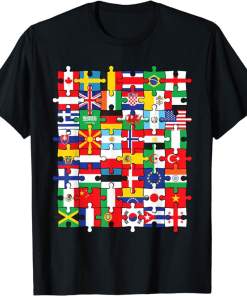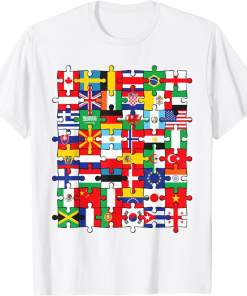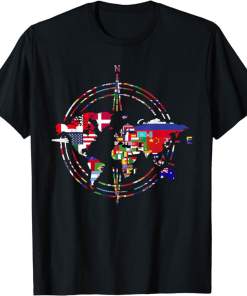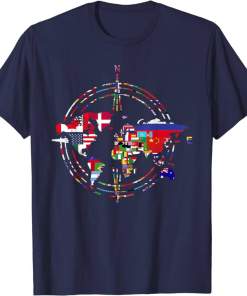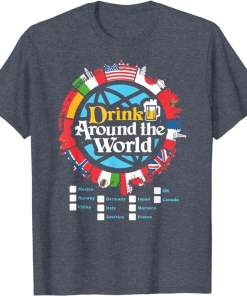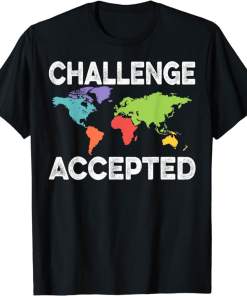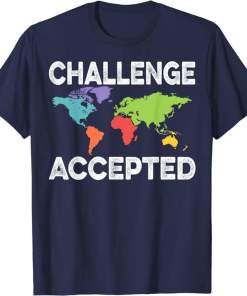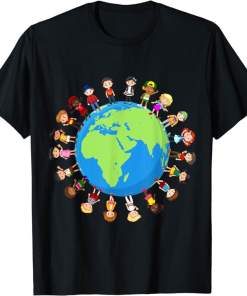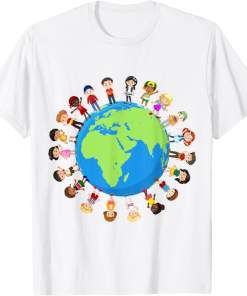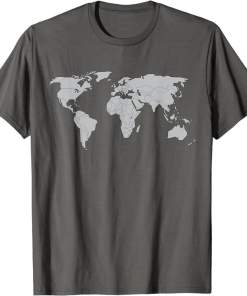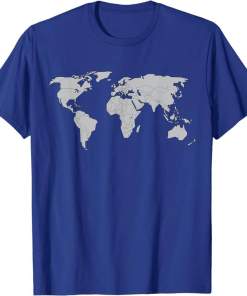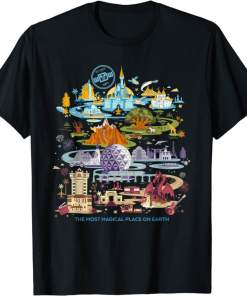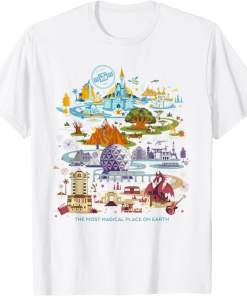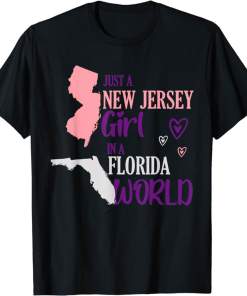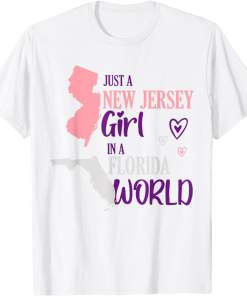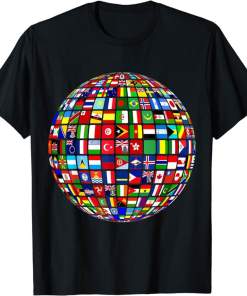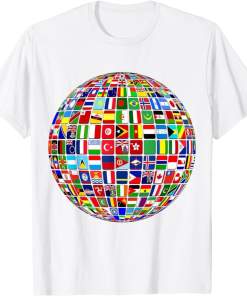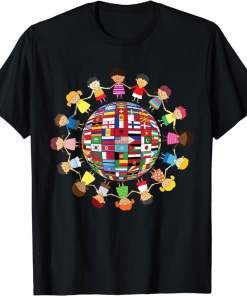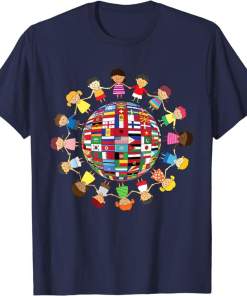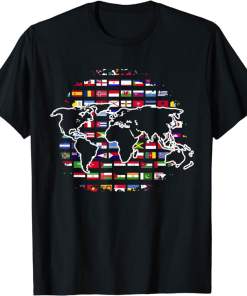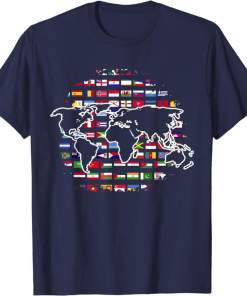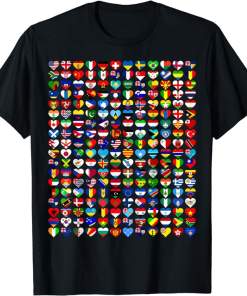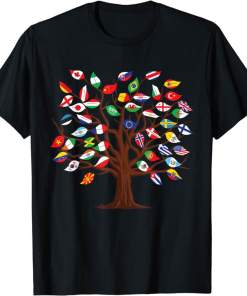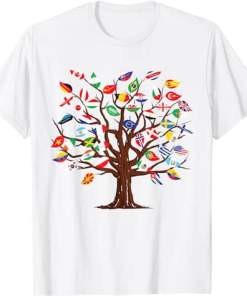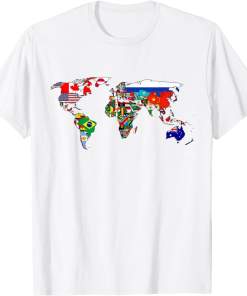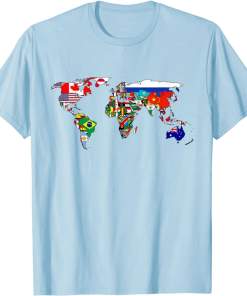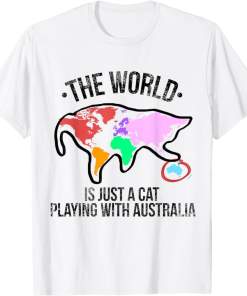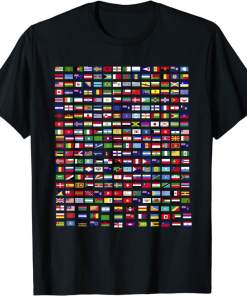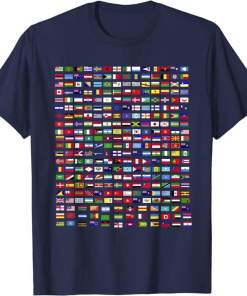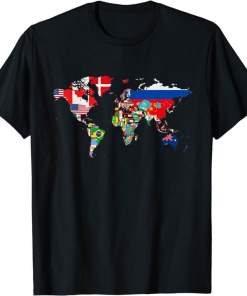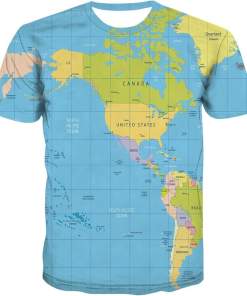Discover the Essence of Fashion – Explore World Of T-shirts Collection at Vilo Trend. World Of T-shirts at Vilo Trend ✓ Iconic designs ✓ Extensive variety ✓ Hassle-free 30-day returns ✓ Dive into the world of World Of T-shirts now! Uncover premium Halloween T-Shirts, uniquely crafted and offered by independent artists, exclusively on Vilo Trend. Experience a spectrum of colors and styles tailored
⏩ You may also love: Green Shirt Guy Wwe
World Of T-shirts
The "World of T-shirts" is a multifaceted and dynamic realm within the broader domain of fashion and culture. In this introductory section, we will define the concept of the "World of T-shirts" and underscore its profound significance and ubiquitous presence in contemporary society.
A. Defining the "World of T-shirts"
The term "World of T-shirts" encapsulates the expansive and ever-evolving domain dedicated to the design, production, consumption, and cultural resonance of T-shirts. It is a comprehensive arena where textiles transform into canvases, and fashion transcends mere clothing. T-shirts, in this context, are more than utilitarian garments; they are vehicles of expression, identity, and communication. The "World of T-shirts" encompasses the entire lifecycle of these iconic apparel items, from their historical origins as undergarments to their present status as symbols of self-expression and collectible art pieces.
B. Significance and Ubiquity of T-shirts in Modern Fashion and Culture
T-shirts, in their various forms and designs, have achieved unparalleled ubiquity and significance in modern fashion and culture. They have transcended the boundaries of gender, age, and socio-economic status to become a universal wardrobe staple. The humble T-shirt is a canvas upon which the zeitgeist of a given era is painted—a wearable medium through which individuals communicate their beliefs, affiliations, and aspirations. T-shirts have evolved from their utilitarian beginnings to become cultural artifacts, reflecting the evolution of society itself.
T-shirts have been worn by countless individuals, from political activists making bold statements to musicians and actors conveying their personal style and branding. They have become a symbol of rebellion, solidarity, and personal expression. In this essay, we will delve into the intricate tapestry of the "World of T-shirts," exploring their historical journey, role as agents of self-expression, connection to pop culture, intersection with sustainability, adaptation to the digital age, allure to collectors, and reflection of both the bright and controversial facets of society. In doing so, we will unveil the rich and multifaceted world that exists within this seemingly simple piece of clothing.
A. Exploring the Historical Origins of T-shirts: From Undergarments to Mainstream Fashion
The journey of T-shirts from their humble beginnings as undergarments to their current status as mainstream fashion icons is a testament to their enduring appeal and adaptability. In this section, we will embark on a historical exploration of the origins of T-shirts, tracing their transformation into a ubiquitous element of modern wardrobes and popular culture.
1. Origins as Undergarments
The story of T-shirts commences in the early 20th century when they emerged as undergarments worn primarily by laborers and members of the U.S. Navy. These early T-shirts featured a simple design—a short-sleeved, lightweight garment made from cotton. They served a practical purpose, absorbing sweat and providing a comfortable layer beneath uniforms and work attire.
2. Emergence in Pop Culture
T-shirts began their journey into pop culture during the mid-20th century. One pivotal moment was Marlon Brando's iconic portrayal of Stanley Kowalski in "A Streetcar Named Desire" (1951), where he donned a plain white T-shirt, inadvertently catapulting it into the realm of fashion. Similarly, James Dean's rebellious image in "Rebel Without a Cause" (1955) solidified the T-shirt's status as a symbol of youthful defiance.
3. The Graphic T-shirt Revolution
The 1960s witnessed a significant evolution with the advent of the graphic T-shirt. Bands like The Rolling Stones and The Beatles began incorporating their logos and album art onto T-shirts, effectively merging music and fashion. This transformative shift paved the way for T-shirts to become canvases for self-expression and artistic statements.
4. Cultural and Political Movements
T-shirts played an integral role in various cultural and political movements. The tie-dye T-shirts of the counterculture movement in the 1960s and 1970s became emblems of peace and free expression. Additionally, slogan-bearing T-shirts have been used to voice political opinions, protest injustices, and support causes.
5. High Fashion Adoption
The late 20th century witnessed the integration of T-shirts into high fashion. Designers such as Ralph Lauren and Calvin Klein embraced T-shirts as essential components of their collections, elevating the status of this once-utilitarian garment. Today, luxury brands produce T-shirts adorned with intricate designs and premium materials, often commanding high prices.
6. The Global Phenomenon
The T-shirt's evolution transcends geographical boundaries. It has become a global phenomenon, transcending cultural differences and making a statement in various societies. From streetwear to haute couture, T-shirts continue to adapt, reflecting the ever-changing landscape of fashion.
In summary, the evolution of T-shirts from undergarments to mainstream fashion is a testament to their versatility and cultural significance. These garments have transcended their utilitarian origins to become powerful symbols of self-expression, artistic canvases, and vehicles for cultural and political messages. Their journey through history mirrors the evolution of fashion and society itself, making them an indispensable part of the "World of T-shirts."
B. Discuss key milestones in the evolution of T-shirt styles, designs, and printing techniques.
Throughout their journey from utilitarian undergarments to iconic fashion statements, T-shirts have undergone significant transformations in styles, designs, and printing techniques. This section will delve into the key milestones that have shaped the evolution of T-shirts into the diverse and expressive garments we know today.
1. The Introduction of Graphics:
One of the pivotal moments in the evolution of T-shirts was the incorporation of graphics and designs. This began in the mid-20th century when logos, slogans, and images started appearing on T-shirts. Notably, the Walt Disney Company was among the first to license their characters for T-shirt designs in the 1930s, introducing the concept of graphic T-shirts.
2. Tie-Dye and the Counterculture Movement:
The 1960s witnessed the rise of the tie-dye T-shirt, an iconic style associated with the counterculture movement. Tie-dye techniques allowed for vibrant and psychedelic patterns, reflecting the free-spirited and anti-establishment sentiments of the era. These T-shirts became symbols of peace, love, and individuality.
3. Band Merchandise:
The 1970s marked a significant shift in T-shirt design with the emergence of band merchandise. Bands like The Rolling Stones and The Beatles began using T-shirts as promotional tools for their music. This trend allowed fans to wear their allegiance proudly, and it remains a staple in music and pop culture today.
4. DIY and Customization:
The late 1970s and 1980s saw the rise of DIY (do-it-yourself) T-shirt customization. Punk and punk rock movements encouraged fans to create their own T-shirt designs, often featuring hand-painted artwork, rebellious slogans, and political messages. This era celebrated individuality and self-expression.
5. Digital Printing and Sublimation:
Advancements in printing technology in the late 20th century revolutionized T-shirt design. Digital printing techniques, such as direct-to-garment (DTG) printing, allowed for intricate and full-color designs. Sublimation printing enabled all-over prints, transforming T-shirts into wearable canvases for artists and designers.
6. Streetwear and Collaboration Culture:
The late 20th and early 21st centuries witnessed the rise of streetwear fashion, with T-shirts at its core. Streetwear brands like Supreme and BAPE popularized limited-edition, artist-designed, and collaborative T-shirts. This trend blurred the lines between street fashion, high fashion, and art, elevating T-shirts to collectible status.
7. Sustainable Printing and Eco-Friendly Materials:
As environmental awareness grew, there was a shift towards eco-friendly printing methods and sustainable materials in T-shirt production. Water-based and discharge printing techniques reduced environmental impact, and organic cotton and recycled fabrics became increasingly popular choices.
8. Digital and Augmented Reality Integration:
The digital age brought about innovative changes, with T-shirts integrating digital and augmented reality elements. Some T-shirts feature QR codes that, when scanned with a smartphone, unlock exclusive digital content, bridging the physical and digital worlds.
In summary, the evolution of T-shirt styles, designs, and printing techniques is a rich tapestry of creativity and innovation. From plain undergarments to graphic canvases, tie-dye expressions to digital marvels, T-shirts have continually adapted to reflect the cultural, artistic, and technological trends of their times. These milestones have contributed to the diversity and expressive power of T-shirts in the "World of T-shirts."
A. Highlight the role of T-shirts as a form of personal and social expression.
T-shirts hold a unique and prominent place in the realm of self-expression, both on a personal and societal level. They serve as more than just pieces of clothing; they are powerful canvases that individuals use to convey their thoughts, feelings, affiliations, and identity.
1. Personal Expression:
- Messages and Slogans: T-shirts often bear messages, slogans, or quotes that reflect an individual's beliefs, humor, or attitudes. Whether it's a witty one-liner, a motivational quote, or a statement of personal values, these messages become a part of the wearer's identity.
- Artistic Expression: Many individuals use T-shirts as a means of showcasing their artistic talents or supporting artists. Custom-designed T-shirts, featuring hand-drawn illustrations, paintings, or digital artwork, allow wearers to express their creativity and admiration for art.
- Nostalgia and Sentiment: T-shirts can serve as sentimental reminders of significant events, places, or experiences in one's life. From concert T-shirts to vacation souvenirs, they carry emotional attachments and memories.
2. Social and Cultural Expression:
- Affiliation and Identity: T-shirts often display affiliations with specific groups, organizations, or communities. For example, team jerseys, university merchandise, and club T-shirts signify a person's membership and identity within a particular collective.
- Political and Social Statements: T-shirts have been instrumental in conveying political and social messages. Activists use them to promote causes, raise awareness, and engage in peaceful protests. These garments become symbols of unity and a means of amplifying important issues.
- Cultural References: T-shirts featuring references to movies, TV shows, music, and popular culture are ways for individuals to express their interests and fandom. They become conversation starters and connections between like-minded enthusiasts.
3. Subversion and Counterculture:
- Rebellion and Subversion: T-shirts have a long history of being used as tools of rebellion and subversion against established norms and authorities. They challenge the status quo, provoke thought, and provide a platform for dissenting voices.
- Counterculture Movements: Counterculture movements, such as the punk and hippie movements, adopted T-shirts as symbols of their non-conformist ideologies. These movements used T-shirts to distance themselves from mainstream values.
4. Empowerment and Confidence:
- Empowerment through Fashion: T-shirts empower individuals to take charge of their fashion choices, promoting self-confidence and body positivity. They are available in various styles, sizes, and designs, catering to diverse preferences.
- Inclusivity and Representation: T-shirts designed to celebrate diversity and promote inclusivity have gained popularity. They allow wearers to express solidarity with marginalized groups and advocate for equal rights.
In conclusion, T-shirts play a multifaceted role in personal and social expression. They are not merely garments but powerful vehicles through which individuals can communicate their beliefs, affiliations, and emotions. From conveying personal sentiments to championing social causes, T-shirts serve as wearable canvases that reflect the rich tapestry of human expression within the "World of T-shirts."
B. Discuss how T-shirts have been used to convey political, cultural, and artistic messages.
T-shirts have emerged as dynamic platforms for conveying a wide range of messages, spanning the realms of politics, culture, and art. Their versatility as a canvas for self-expression has allowed them to become powerful vehicles for disseminating ideas, raising awareness, and fostering dialogue in these critical spheres.
1. Political Messages:
- Campaigns and Elections: Political T-shirts are a common sight during election seasons. Supporters of candidates adorn campaign T-shirts that display the candidate's name, slogan, and emblem. These shirts serve as both a statement of allegiance and a means of mobilizing voters.
- Protests and Movements: T-shirts play a significant role in political protests and social movements. Activists often wear T-shirts featuring powerful slogans, images, or calls to action. For instance, during the civil rights movement, T-shirts with messages like "I AM A MAN" were worn to demand equality.
- Political Satire: T-shirts can be used to convey political satire and commentary. They serve as a medium for humor and critique, allowing individuals to express their perspectives on political figures, policies, and events.
2. Cultural Messages:
- Pop Culture References: T-shirts often feature references to movies, TV shows, music, and other elements of pop culture. These references act as a form of cultural shorthand, instantly connecting fans and enthusiasts who share a common appreciation.
- Celebrity and Iconography: T-shirts bearing the likenesses of celebrities, cultural icons, and historical figures are worn as a mark of admiration and influence. They serve as a tribute to the impact these individuals have had on society.
- Cultural Celebrations: T-shirts are used to commemorate cultural celebrations and events. They can display symbols, images, and messages related to cultural heritage, holidays, festivals, and traditions.
3. Artistic Messages:
- Art as Wearable: T-shirts provide a mobile canvas for artists to showcase their work. Custom-designed T-shirts featuring hand-drawn illustrations, paintings, or digital art allow artists to reach a broader audience and transform their creations into wearable art.
- Artistic Movements: T-shirts have been associated with various art movements. For example, the Surrealist movement saw artists like Salvador Dalí and René Magritte create T-shirt designs that embodied their surreal and imaginative styles.
- Artistic Statements: T-shirts can convey artistic statements, whether through abstract designs, minimalist aesthetics, or intricate patterns. They allow artists to communicate their unique vision and perspective.
In essence, T-shirts have become dynamic canvases for political, cultural, and artistic messages. They enable individuals and groups to express their affiliations, beliefs, and creativity while engaging with broader societal dialogues. Whether it's through political slogans, cultural references, or artistic designs, T-shirts have the power to spark conversations and forge connections within the "World of T-shirts."
A. Analyze the impact of pop culture on T-shirt trends and designs.
The symbiotic relationship between T-shirt fashion and pop culture is a testament to the profound influence that popular culture exerts on T-shirt trends and designs. In this section, we will delve into the ways in which pop culture shapes and molds the aesthetics, themes, and appeal of T-shirts.
1. Celebrity Endorsement:
- Celebrity Merchandise: Pop culture icons, including musicians, actors, athletes, and social media influencers, have a considerable impact on T-shirt trends. When these celebrities release their merchandise, fans eagerly embrace it. Concert T-shirts, in particular, serve as tangible mementos of live experiences.
- Red Carpet Moments: High-profile events like award ceremonies and premieres often feature celebrities wearing T-shirts with provocative slogans or designs. These appearances can catalyze trends and send messages that resonate with audiences.
2. Movie and TV References:
- Character and Quote T-shirts: Iconic characters and memorable quotes from movies and TV shows frequently find their way onto T-shirts. Fans love wearing shirts that pay homage to their favorite films or series, creating a sense of belonging within fandoms.
- Limited Edition Collaborations: The collaboration between T-shirt brands and major film studios or TV networks has led to limited edition collections. These T-shirts often feature exclusive designs tied to specific cinematic releases or series launches.
3. Music Culture:
- Band and Album Art: T-shirts featuring band logos and album artwork have been a staple of music culture for decades. The imagery associated with musicians and bands becomes emblematic, offering fans a tangible connection to their favorite artists.
- Music Subgenres: Pop culture's influence extends to various music subgenres, with specific T-shirt styles catering to fans of genres like punk, hip-hop, metal, and EDM. Each subgenre has its own distinct fashion and design aesthetics.
4. Internet and Memes:
- Virality and Memes: The rapid spread of internet memes often leads to meme-themed T-shirts. These shirts capture the zeitgeist of online culture and enable individuals to participate in internet phenomena.
- Online Communities: Pop culture references and memes foster a sense of community and shared humor among internet users. T-shirts with meme-related content become a form of digital camaraderie.
5. Fashion Icons and Trends:
- Influential Designers: Fashion designers and brands frequently draw inspiration from pop culture, infusing their collections with references to iconic movies, music, or celebrities. T-shirts are integral components of these collections.
- Retro Revival: Pop culture often witnesses periods of nostalgia when fashion from bygone eras makes a comeback. Retro-themed T-shirts featuring vintage logos, characters, or styles capitalize on this cyclical trend.
In essence, pop culture serves as both a wellspring of inspiration and a driving force behind T-shirt trends and designs. Celebrities, movies, TV shows, music, internet culture, and fashion icons all contribute to the vibrant and ever-evolving tapestry of T-shirt fashion. These garments act as canvases that capture and celebrate the zeitgeist of their respective eras within the "World of T-shirts."
B. Provide examples of iconic T-shirts associated with movies, music, and celebrities.
Iconic T-shirts associated with movies, music, and celebrities have left an indelible mark on pop culture and fashion. These T-shirts not only reflect the influence of the entertainment industry but also serve as collectible items that pay homage to beloved films, musicians, and public figures. Here are some notable examples:
Movies:
- "Jaws" Poster T-shirt: The iconic movie poster for Steven Spielberg's "Jaws" featuring the great white shark emerging from the water has been recreated on countless T-shirts. It's an enduring symbol of suspense and the power of cinema.
- "Star Wars" Logo T-shirt: The classic "Star Wars" logo emblazoned on a T-shirt is an homage to one of the most influential and beloved film franchises in history. It's instantly recognizable to fans around the world.
- "Pulp Fiction" Mia Wallace T-shirt: Uma Thurman's character, Mia Wallace, in Quentin Tarantino's "Pulp Fiction" is known for her distinctive black bob and white shirt. Her iconic look has become a fashion statement and a popular T-shirt design.
Music:
- The Rolling Stones' "Tongue and Lips" T-shirt: The Rolling Stones' logo featuring a protruding tongue and lips is one of the most recognizable symbols in music. It has been printed on T-shirts and worn by fans for decades.
- Nirvana's "Smiley Face" T-shirt: Nirvana's smiley face logo from their "Nevermind" album cover has become an enduring symbol of 1990s grunge music. The T-shirt featuring this design is iconic in the world of music merchandise.
- The Ramones' Logo T-shirt: The simple yet striking T-shirt with The Ramones' logo, featuring the band's name in a bold, minimalist style, has become an emblem of punk rock and a fashion staple.
Celebrities:
- Che Guevara T-shirt: Featuring the image of revolutionary leader Che Guevara, this T-shirt has become a symbol of rebellion and counterculture. It's often worn as a statement of political and social activism.
- Marilyn Monroe T-shirt: Marilyn Monroe's iconic pose from "The Seven Year Itch" with her white dress billowing up has been immortalized on T-shirts. It represents the enduring allure of Hollywood glamour.
- Bob Marley T-shirt: T-shirts featuring the image of reggae legend Bob Marley have become synonymous with the celebration of music, peace, and unity. His image is a symbol of the global reach of reggae culture.
These iconic T-shirts not only celebrate the cultural impact of movies, music, and celebrities but also demonstrate the power of fashion to connect individuals with the art and personalities they admire. They continue to be cherished collectibles and expressions of fandom within the "World of T-shirts."
A. Explore the intersection of T-shirts with sustainable fashion and ethical manufacturing.
In recent years, the fashion industry has seen a growing intersection between T-shirts and sustainable practices, reflecting an increased awareness of environmental and ethical concerns. T-shirts, as ubiquitous fashion items, have become a focal point for sustainable fashion initiatives and ethical manufacturing practices.
1. Sustainable Materials:
- Organic Cotton T-shirts: One of the most significant advancements in sustainable T-shirt production is the use of organic cotton. Organic cotton is grown without the use of synthetic pesticides and fertilizers, reducing the environmental impact of cotton farming.
- Recycled Materials: Some T-shirts are now made from recycled materials, including post-consumer plastic bottles and reclaimed cotton. This reduces waste and lessens the demand for virgin resources.
2. Eco-Friendly Printing Techniques:
- Water-Based Inks: Traditional screen printing often uses plastisol inks that contain harmful chemicals. Sustainable T-shirt printing now employs water-based inks that are more environmentally friendly and produce vibrant colors.
- Digital Printing: Digital printing methods like direct-to-garment (DTG) and sublimation use fewer resources and generate less waste compared to traditional printing techniques.
3. Ethical Manufacturing:
- Fair Labor Practices: Ethical T-shirt brands prioritize fair labor practices, ensuring that workers are paid fair wages, provided safe working conditions, and have the right to collective bargaining.
- Local Production: Some brands opt for local manufacturing to reduce the carbon footprint associated with international shipping and to support local economies.
4. Slow Fashion and Longevity:
- Quality Over Quantity: Sustainable T-shirts are often designed with durability in mind, using higher-quality materials and construction techniques. This encourages consumers to buy fewer, longer-lasting items.
- Repair and Upcycling: Sustainable fashion encourages consumers to repair and upcycle their T-shirts, extending their lifespan and reducing waste.
5. Transparent Supply Chains:
- Supply Chain Traceability: Ethical T-shirt brands often provide transparency about their supply chains, allowing consumers to trace the journey of their garments from raw materials to finished products.
6. Minimalist and Timeless Designs:
- Timeless Appeal: Sustainable T-shirts often feature minimalist and timeless designs that remain fashionable over the years, discouraging fast fashion consumption.
- Versatility: T-shirts with classic designs can be easily integrated into various outfits, promoting versatility and reducing the need for excessive clothing.
The intersection of T-shirts with sustainable fashion and ethical manufacturing represents a significant shift towards more responsible consumer choices. By choosing sustainable T-shirts, individuals can contribute to reducing the environmental impact of the fashion industry and supporting ethical labor practices. It reflects a growing understanding that even everyday items like T-shirts can play a role in creating a more sustainable and ethical "World of T-shirts."
B. Discuss initiatives to reduce the environmental impact of T-shirt production and consumption.
As awareness of environmental concerns in the fashion industry grows, various initiatives have emerged to reduce the environmental impact of T-shirt production and consumption. These initiatives span from sustainable materials to responsible consumption practices, fostering a more eco-conscious "World of T-shirts."
1. Sustainable Materials:
- Organic Cotton Farming: Initiatives promote the use of organic cotton, which is cultivated without synthetic pesticides or fertilizers. This reduces soil and water pollution while promoting healthier farming practices.
- Recycled Materials: Brands are increasingly using recycled materials, such as post-consumer plastic bottles and reclaimed cotton, to create T-shirts. This reduces the demand for virgin resources and helps divert waste from landfills.
2. Eco-Friendly Printing Practices:
- Water-Based Inks: The adoption of water-based inks in T-shirt printing significantly reduces the environmental impact compared to traditional plastisol inks. Water-based inks produce less hazardous waste and are safer for workers.
- Digital Printing Technologies: Digital printing methods like direct-to-garment (DTG) and sublimation use fewer resources, generate less waste, and allow for on-demand production, reducing overstock and waste.
3. Ethical Manufacturing and Labor Practices:
- Fair Trade Certification: Some T-shirt brands seek Fair Trade certification, ensuring that workers involved in production are paid fair wages and work in safe conditions. This promotes ethical manufacturing and supports communities.
- Local Production: Brands are exploring local manufacturing options to minimize the environmental impact of long-distance shipping and to support regional economies.
4. Sustainable Packaging:
- Minimalist Packaging: Brands are adopting minimalist and eco-friendly packaging options, reducing plastic waste and using recyclable materials for shipping and presentation.
- Reducing Single-Use Plastics: Initiatives aim to reduce single-use plastics in T-shirt packaging by opting for alternatives like compostable bags or reusable packaging.
5. Clothing Care and Repair:
- Consumer Education: Initiatives encourage consumers to care for their T-shirts properly, which extends their lifespan. Tips for washing, storing, and repairing T-shirts help reduce the frequency of replacements.
- Upcycling Workshops: Brands and organizations organize workshops and events that teach consumers how to upcycle their old T-shirts into new garments or accessories.
6. Secondhand and Vintage Markets:
- Thrifting and Resale Platforms: The rise of thrifting and online resale platforms encourages consumers to buy secondhand T-shirts, extending the life of garments and reducing the demand for new production.
7. Slow Fashion Movements:
- Quality Over Quantity: Slow fashion movements promote a shift in consumer mentality, emphasizing the value of investing in high-quality, timeless T-shirts that last longer and reduce the need for constant replacement.
8. Eco-Certifications and Labeling:
- Eco-Certified Products: Certifications like Global Organic Textile Standard (GOTS) and OEKO-TEX certify T-shirts as eco-friendly and safe for consumers. Labels make it easier for consumers to identify sustainable options.
These initiatives collectively contribute to reducing the environmental impact of T-shirt production and consumption. By adopting sustainable materials, ethical practices, responsible packaging, and conscious consumption habits, the fashion industry and consumers alike can work together to create a more environmentally friendly and sustainable "World of T-shirts."
A. Examine the role of e-commerce and online customization in the T-shirt industry.
The advent of the digital age has revolutionized the T-shirt industry, introducing e-commerce and online customization as integral components. This transformation has not only changed how T-shirts are bought and sold but has also empowered consumers to become active participants in the design and creation process.
1. E-commerce in T-shirt Retail:
- Global Accessibility: E-commerce platforms have made T-shirts accessible to a global audience. Shoppers can browse and purchase T-shirts from anywhere with an internet connection, transcending geographical boundaries.
- Diverse Selection: Online marketplaces offer a vast array of T-shirt styles, designs, and brands. Consumers have an extensive selection to choose from, including niche and independent brands.
- Convenience: E-commerce provides unparalleled convenience. Shoppers can browse, compare, and make purchases at any time, eliminating the constraints of traditional retail store hours.
- User Reviews and Ratings: Online platforms allow customers to leave reviews and ratings, helping others make informed purchasing decisions based on real experiences.
2. Online Customization:
- Personalized Design: Online customization tools enable consumers to personalize their T-shirts. They can choose colors, graphics, text, and even upload their designs, creating unique and one-of-a-kind garments.
- Print-On-Demand Services: Print-on-demand services have emerged, allowing consumers to order custom-designed T-shirts that are produced only when an order is placed. This reduces overproduction and waste.
- Collaborations and Merchandise: Celebrities, influencers, and brands collaborate with online customization platforms to release limited-edition T-shirt collections, further fueling the demand for personalized designs.
3. Community and Social Sharing:
- User-Generated Content: Social media platforms enable users to share images and videos of themselves wearing T-shirts, creating a culture of user-generated content. This content can influence fashion trends and brand perceptions.
- Influencer Marketing: Influencers often showcase T-shirts on their social media profiles, influencing their followers' fashion choices and promoting brands through digital endorsements.
4. Sustainability and Transparency:
- Eco-Friendly Options: E-commerce platforms often feature eco-friendly T-shirt options, making it easier for consumers to choose sustainable products.
- Transparency: Brands can use online channels to communicate their sustainability practices, ethical sourcing, and production processes, fostering trust and loyalty among consumers.
5. Data-Driven Insights:
- Consumer Insights: E-commerce platforms gather data on consumer preferences and behavior, enabling brands to tailor their T-shirt offerings and marketing strategies to better align with customer demands.
6. Accessibility for Independent Creators:
- Independent Designers: Independent designers and artists can utilize e-commerce and online customization platforms to reach a wider audience and turn their creative ideas into profitable ventures.
The role of e-commerce and online customization in the T-shirt industry is transformative. It empowers consumers with unprecedented choices and control over their fashion preferences while opening new opportunities for businesses and creators. As the digital age continues to evolve, the T-shirt industry is likely to see even more innovation and integration with technology.
B. Discuss the influence of social media on T-shirt trends and marketing.
Social media has become a powerful force shaping T-shirt trends and revolutionizing marketing strategies within the fashion industry. Its impact is pervasive, from driving viral trends to providing direct communication channels between brands and consumers.
1. Viral Trends and Challenges:
- Hashtag Campaigns: Brands create hashtag campaigns that encourage users to share images of themselves wearing specific T-shirts. These campaigns can quickly go viral, spreading fashion trends globally.
- Challenges and Movements: Social media platforms are instrumental in promoting challenges and movements related to T-shirt fashion. Examples include the ALS Ice Bucket Challenge and movements advocating for sustainability in fashion.
2. Influencer Marketing:
- Fashion Influencers: Fashion influencers and bloggers leverage their social media presence to showcase T-shirts, influencing their followers' purchasing decisions. Collaborations with influencers have become a common marketing strategy.
- Authenticity: Authenticity is key in influencer marketing. Followers often appreciate genuine endorsements and recommendations, making influencer partnerships a valuable tool for T-shirt brands.
3. User-Generated Content:
- Tagged Posts: Brands encourage customers to share photos of themselves wearing branded T-shirts, tagging the brand in their posts. These user-generated photos serve as authentic endorsements and social proof.
- Social Sharing: Social media platforms facilitate the sharing of T-shirt-related content among friends and followers, further amplifying brand exposure and creating a sense of community.
4. Real-Time Engagement:
- Live Streams and Stories: Brands use live streams and Stories on platforms like Instagram to engage with their audience in real time. This allows for instant feedback, Q&A sessions, and exclusive product launches.
- Feedback and Polls: Brands can gather valuable insights through social media by running polls and surveys, gauging customer preferences, and adapting their T-shirt offerings accordingly.
5. Trends and Insights:
- Monitoring Trends: Brands closely monitor social media platforms to identify emerging T-shirt trends and consumer preferences. This real-time data informs their design and marketing strategies.
- Competitor Analysis: Brands analyze competitors' social media activities to gain insights into successful marketing campaigns and consumer engagement.
6. Direct-to-Consumer Interaction:
- Customer Service: Social media platforms serve as channels for customer service, allowing brands to address inquiries, concerns, and feedback promptly.
- Transparency and Authenticity: Brands can convey transparency and authenticity by sharing behind-the-scenes content, showcasing their ethical practices, and responding to consumer inquiries publicly.
7. Targeted Advertising:
- Data-Driven Advertising: Social media platforms offer data-driven advertising options, allowing brands to target specific demographics with T-shirt ads based on user interests, behavior, and engagement.
Social media's influence on T-shirt trends and marketing is undeniable. It democratizes fashion by giving consumers a voice, connects brands with their audience in real time, and provides a platform for showcasing the latest T-shirt styles and designs. As social media continues to evolve, its impact on the T-shirt industry is likely to deepen, shaping the future of fashion marketing and consumer engagement.
A. Highlight the phenomenon of T-shirt collecting and the value of rare or vintage designs.
The phenomenon of T-shirt collecting has gained significant traction in recent years, with enthusiasts actively seeking out and preserving T-shirts that hold historical, cultural, or personal significance. This collecting subculture has elevated certain T-shirts, particularly rare or vintage designs, to the status of coveted treasures.
1. Rare and Vintage T-shirts:
- Historical Significance: T-shirts that bear historical significance, such as concert tour shirts or promotional merchandise from iconic events, are highly sought after. Examples include vintage rock band T-shirts and limited-edition sports event shirts.
- Nostalgia: Many collectors are driven by nostalgia, seeking T-shirts that harken back to a specific era or cultural moment. Vintage T-shirts from the 1980s or 1990s, featuring pop culture references, are particularly popular.
- Limited Runs: T-shirts produced in limited quantities or as part of exclusive collaborations become rare collector's items. These items often appreciate in value over time.
2. Brand and Designer Collaborations:
- High-Fashion Collaborations: Collaborations between high-fashion designers and streetwear brands have created a niche market for collectible T-shirts. These collaborations combine luxury with street cred, attracting fashion-forward collectors.
- Artistic Collaborations: Collaborations with renowned artists or graphic designers result in T-shirts that are both wearable art and collector's pieces. These collaborations often feature unique prints and designs.
3. Preservation and Authentication:
- Archival Methods: Collectors take great care to preserve their T-shirt collections by using archival storage techniques. This includes protecting against fading, yellowing, and deterioration.
- Authentication: Authenticity is crucial in the world of T-shirt collecting. Some rare T-shirts are subject to authentication processes to verify their origin and provenance.
4. Online Marketplaces and Communities:
- Online Marketplaces: Websites and platforms dedicated to T-shirt collecting allow enthusiasts to buy, sell, and trade vintage and rare T-shirts. These platforms connect collectors from around the world.
- Collector Communities: Online communities, forums, and social media groups cater to T-shirt collectors. Members share their collections, swap stories, and engage in trading and selling.
5. Investment Value:
- Appreciating Value: Rare and vintage T-shirts often appreciate in value over time, making them attractive investments for collectors. Some pieces have been known to sell for thousands of dollars.
- Alternative Investments: T-shirt collecting represents an alternative form of investment, where passion for fashion intersects with potential financial gain.
The phenomenon of T-shirt collecting underscores the idea that T-shirts are not just garments; they are cultural artifacts with a rich history and a vibrant subculture surrounding them. Collectors celebrate the artistry, craftsmanship, and nostalgia associated with T-shirts, elevating them from casual wear to cherished, valuable items. This phenomenon reflects the enduring allure of T-shirts in the world of fashion and culture.
B. Explore the subculture of T-shirt enthusiasts and collectors.
Within the broader world of fashion and pop culture, there exists a dedicated subculture of T-shirt enthusiasts and collectors who are passionate about the artistry, history, and cultural significance of these seemingly simple garments. This subculture forms a tight-knit community bonded by their shared love for T-shirts.
1. T-shirt Enthusiasts and Collectors:
- Diverse Backgrounds: T-shirt collectors come from diverse backgrounds, including fashion aficionados, vintage enthusiasts, music fans, and art connoisseurs. Their common thread is a deep appreciation for T-shirts as wearable art and cultural artifacts.
- Treasure Hunters: Many collectors see themselves as treasure hunters, constantly searching for rare, vintage, or limited-edition T-shirts that hold unique stories and historical value.
- Archivists: Some collectors adopt the role of archivists, meticulously cataloging and preserving their T-shirt collections. They may create digital databases or physical archives to document the provenance of each piece.
2. Collecting Motivations:
- Nostalgia: Nostalgia plays a significant role in T-shirt collecting. Collectors often seek out T-shirts that evoke memories of their youth, favorite bands, or cultural moments.
- Fashion Statements: T-shirt enthusiasts see their collections as a way to make fashion statements. They wear their rare or unique T-shirts proudly, expressing their individuality and taste.
- Investment: Some collectors view T-shirts as investments, anticipating that the value of rare pieces will appreciate over time. They engage in buying, selling, and trading to build valuable collections.
3. T-shirt Communities:
- Online Forums: T-shirt collectors gather on online forums and communities dedicated to T-shirt collecting. These platforms serve as spaces for sharing stories, showcasing collections, and discussing trends.
- Social Media: Social media platforms, particularly Instagram, have become popular for displaying T-shirt collections and connecting with fellow enthusiasts through hashtags and accounts dedicated to T-shirt culture.
- Local Meetups: In some regions, collectors organize local meetups, swap meets, and T-shirt-related events, fostering real-world connections among enthusiasts.
4. Knowledge and Expertise:
- Historical Knowledge: Experienced collectors often possess in-depth knowledge of T-shirt history, including iconic designs, brands, and printing techniques. They can identify valuable vintage pieces.
- Authentication Skills: Authentication is a critical skill in the T-shirt collecting world. Collectors become experts in identifying genuine vintage T-shirts and distinguishing them from replicas.
5. Collaborations and Limited Editions:
- Hunting for Collaborations: Collectors are particularly drawn to T-shirts resulting from collaborations between brands, artists, musicians, and designers. Limited-edition releases are highly coveted.
- Storytelling through T-shirts: T-shirt enthusiasts appreciate the stories behind each piece in their collection. They often research the origin and significance of a T-shirt, adding depth to their narrative.
The subculture of T-shirt enthusiasts and collectors is a testament to the enduring allure of this versatile garment. It thrives on the shared passion for discovering, preserving, and celebrating the cultural and artistic significance of T-shirts, making it a vibrant and inclusive community within the broader world of fashion and pop culture.
A. Address controversies related to offensive or inappropriate T-shirt designs.
While T-shirts are a canvas for self-expression, they have not been immune to controversies stemming from offensive or inappropriate designs. Such controversies have raised ethical concerns and prompted discussions about the boundaries of freedom of expression in the fashion industry.
1. Offensive Graphics and Messages:
- Stereotyping and Insensitivity: Some T-shirts have featured graphics and messages that perpetuate stereotypes, target specific ethnic or social groups, or make light of sensitive issues such as racism, sexism, or mental health.
- Cultural Appropriation: T-shirt designs that appropriate elements from other cultures, often without understanding or respect, have generated outrage for their insensitivity and lack of cultural appreciation.
- Shock Value: Certain T-shirt designs aim for shock value by using explicit, offensive, or provocative imagery or language. These designs are often created to garner attention but can lead to backlash.
2. Brand Missteps:
- Brands and Public Perception: Controversial T-shirt designs can damage a brand's reputation and public image. Brands that are seen as insensitive or offensive risk losing customers and credibility.
- Apologies and Recall: In response to public outcry, some brands have been forced to issue apologies and recall offensive T-shirt designs. These incidents highlight the need for responsible design and vetting processes.
3. Calls for Accountability:
- Consumer Activism: Social media amplifies consumer voices, enabling activists and concerned individuals to call out brands and demand accountability for offensive T-shirt designs.
- Boycotts: Controversies surrounding T-shirt designs have led to boycotts of offending brands or calls for consumers to support brands that prioritize ethical and inclusive design.
4. Ethical Considerations:
- Freedom of Expression: Controversies surrounding T-shirt designs raise questions about the limits of freedom of expression in fashion. Balancing creative freedom with responsible design is an ongoing challenge.
- Corporate Responsibility: Brands face increasing pressure to adopt responsible design practices, conduct thorough vetting, and prioritize ethics in their supply chains to avoid contributing to offensive or harmful narratives.
5. Promoting Inclusivity and Representation:
- Inclusive Designs: Brands and designers are taking steps to create T-shirts that celebrate diversity, promote inclusivity, and raise awareness about important social issues.
- Representation Matters: Many activists emphasize the importance of representation in T-shirt design, advocating for accurate and respectful depictions of underrepresented groups.
6. Collaborations and Influencer Responsibility:
- Responsibility of Collaborators: Celebrities, influencers, and artists who collaborate with brands also face scrutiny for their involvement in controversial T-shirt designs. They may be called upon to take a stand on ethical considerations.
Addressing controversies related to offensive or inappropriate T-shirt designs is an ongoing challenge for the fashion industry. These incidents underscore the importance of ethical design practices, responsible vetting, and a commitment to fostering a more inclusive and respectful fashion culture that balances creative expression with societal responsibility.
B. Discuss ethical concerns regarding labor conditions and copyright infringement in the T-shirt industry.
The T-shirt industry, like many sectors of the fashion world, is not immune to ethical concerns related to labor conditions and copyright infringement. These issues raise questions about the treatment of workers and the protection of intellectual property.
1. Labor Conditions:
- Sweatshops and Exploitation: Ethical concerns often revolve around the manufacturing process. Some T-shirt factories, especially in low-wage countries, have been criticized for operating in sweatshop-like conditions, where workers endure long hours, low pay, and poor working conditions.
- Fair Wages and Workers' Rights: Ethical consumers and advocacy groups push for fair wages, safe workplaces, and respect for workers' rights throughout the T-shirt supply chain, from cotton farming to production.
- Sustainable Practices: There is growing interest in sustainability and ethical sourcing of materials. Consumers seek T-shirts made from organic cotton or other eco-friendly fabrics to reduce environmental impact.
2. Copyright Infringement:
- Counterfeit Merchandise: The fashion industry, including T-shirt production, faces challenges related to counterfeit merchandise. Unauthorized reproductions of copyrighted logos, designs, and artwork can deceive consumers and harm brand integrity.
- Plagiarism: Some T-shirt designs are accused of plagiarizing artwork, graphics, or slogans from independent artists or smaller creators, raising questions about intellectual property rights and creative integrity.
3. Counterfeit Merchandise and Online Marketplaces:
- Online Sales: The digital age has made it easier for counterfeiters to sell fake T-shirts on online marketplaces. Brands and consumers alike must be vigilant in identifying and reporting such listings.
- Brand Dilution: Copyright infringement not only impacts creators but also dilutes the value of established brands. Legitimate T-shirt brands may suffer when counterfeit copies flood the market.
4. Ethical Sourcing and Transparency:
- Ethical Sourcing Programs: Some brands have adopted ethical sourcing programs that prioritize fair labor practices, traceability, and transparency in their supply chains. They work with factories that adhere to ethical standards.
- Transparency Initiatives: Brands are increasingly transparent about their manufacturing processes, sharing information about factory locations, working conditions, and efforts to improve ethical practices.
5. Intellectual Property Protection:
- Trademark and Copyright Enforcement: Brands and artists seek legal remedies to protect their intellectual property. This includes taking legal action against counterfeiters and those who plagiarize designs.
- Licensing Agreements: Some T-shirt collaborations involve licensing agreements, ensuring that artists are compensated for their work and that the brand has the legal right to use the designs.
Addressing ethical concerns related to labor conditions and copyright infringement requires a multi-faceted approach involving brands, consumers, and regulatory bodies. Brands that prioritize ethical practices can set industry standards, while consumers can make informed choices that support ethical and sustainable T-shirt production. Additionally, robust intellectual property protection and enforcement mechanisms are essential to combating copyright infringement in the industry.
VI. T-shirts in the Digital Age
IX. The Future of T-shirts
A. Speculate on emerging trends and innovations in T-shirt fashion.
The future of T-shirts promises to be an exciting and dynamic landscape, characterized by innovative design concepts and a continued evolution of the garment's role in fashion and culture. Several emerging trends and innovations are likely to shape the T-shirt industry:
1. Sustainable Materials and Practices:
- Circular Fashion: The adoption of circular fashion principles will become more prominent. T-shirts made from recycled materials, organic cotton, and biodegradable fabrics will gain popularity, aligning with eco-conscious consumer preferences.
- Zero Waste Design: Designers may experiment with zero-waste patterns and manufacturing techniques, minimizing fabric waste during production.
2. Smart T-shirts:
- Embedded Technology: Smart T-shirts with embedded sensors or electronic components will enable functions like temperature regulation, fitness tracking, and even augmented reality experiences.
- Interactive Graphics: T-shirts may feature interactive graphics that respond to touch or environmental factors, allowing wearers to customize their appearance.
3. Personalization and Customization:
- On-Demand Printing: Advances in on-demand printing technology will enable consumers to order custom-designed T-shirts online, allowing for unique, one-of-a-kind creations.
- 3D Printing: 3D printing technology may be applied to T-shirt design, allowing for intricate and customizable textures and patterns.
4. Inclusivity and Representation:
- Size and Gender Inclusivity: T-shirt brands will continue to expand size ranges and embrace gender-inclusive designs, ensuring that T-shirts cater to a diverse audience.
- Diverse Artistic Collaborations: Collaborations with artists and designers from underrepresented communities will become more common, leading to T-shirts that celebrate diverse cultures and perspectives.
5. Nostalgia and Retro Revivals:
- Nostalgic Designs: Nostalgia will remain a driving force in T-shirt fashion. Vintage-inspired T-shirts featuring pop culture references from different decades will continue to be in demand.
- Retro Brand Resurrections: Brands may revive retro logos and designs to tap into the nostalgia market, creating a fusion of old and new styles.
6. Sustainability in Packaging:
- Eco-Friendly Packaging: Brands will extend their sustainability efforts to packaging, adopting eco-friendly materials and practices for T-shirt packaging and shipping.
B. Reflect on the enduring appeal and adaptability of T-shirts in an ever-changing world of fashion.
T-shirts have demonstrated an enduring appeal and adaptability that few other fashion items can match. Their continued relevance in the ever-changing world of fashion can be attributed to several factors:
- Versatility: T-shirts are inherently versatile. They can be dressed up or down, layered, accessorized, or worn as standalone pieces, making them suitable for various occasions and style preferences.
- Blank Canvas: T-shirts serve as a blank canvas for self-expression. They allow wearers to convey their identities, beliefs, and affiliations through graphics, slogans, and designs.
- Cultural Significance: T-shirts often reflect cultural trends, music, art, and social movements. They serve as tangible markers of specific moments in time and collective memory.
- Accessibility: T-shirts are affordable and accessible to a wide range of consumers, making fashion and self-expression attainable for a diverse audience.
- Adaptability: T-shirts seamlessly adapt to emerging fashion trends and technologies. They are a medium through which designers can experiment with new ideas and materials.
- Enduring Comfort: Comfort remains a key criterion in fashion, and T-shirts excel in this aspect. Their breathable and easy-to-wear nature ensures their place in modern wardrobes.
In conclusion, the future of T-shirts promises a blend of innovation, sustainability, inclusivity, and adaptability. While they continue to evolve in response to changing consumer preferences and technological advancements, their enduring appeal as a fashion staple and cultural canvas remains unwavering. The T-shirt's unique ability to bridge fashion, culture, and personal expression ensures its continued relevance in the world of fashion.

